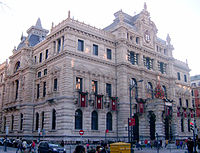This is an old revision of this page, as edited by Deibid (talk | contribs) at 14:28, 6 May 2006. The present address (URL) is a permanent link to this revision, which may differ significantly from the current revision.
Revision as of 14:28, 6 May 2006 by Deibid (talk | contribs)(diff) ← Previous revision | Latest revision (diff) | Newer revision → (diff)



Biscay (Basque Bizkaia, Spanish: Vizcaya) is a province of northern Spain, in the northwestern part of the autonomous community of the Basque Country.
Population
Of the 1,133,444 people who live in Biscay, about 30% live in the capital, Bilbao (Basque: Bilbo) and 88% in its metropolitan area. Population density is 512.34 /km². Guernica (Basque: Gernika-Lumo), a town regarded as the spiritual centre of the traditional Basque Country, is located in Biscay.
Other important towns include Barakaldo, Getxo, Portugalete, Durango, and Balmaseda. See List of municipalities in Biscay.
Biscayan is a dialect of the Basque language spoken in the region.
Geography
Biscay is bordered by the provinces of Cantabria and Burgos to the west, Guipúzcoa to the east, and Álava to the south, and by the Cantabrian Sea (Bay of Biscay) to the north. Orduña is a Biscayan enclave inside Álava. Area: 2,217 km². Shore: 80 km.
The climate is oceanic, with high precipitation all year round and moderate temperatures, which allow the lush vegetation to grow.
The main features of the province are:
- The southern mountain ranges that form a continuous barrier with passes not lower than 600 m AMSL, forming the watershed of the Atlantic and Mediterranean bassins. These ranges are divided from west to east in Ordunte (Zalama, 1390 m), Orduña (1100 m), Gorbea (1481 m) and Urkiola (Anboto, 1296 m).
- The middle section which is occupied by the main river's valleys: Nervion, Ibaizabal and Kadagua. Kadagua runs west to east from Ordunte, Nervion south to north from Orduña and Ibaizabal east to west from Urkiola. Arratia river runs northwards from Gorbea and joins Ibaizabal.
- The coast: the main features are the estuary of Bilbao where the main rivers meet the sea and the estuary of Gernika (Urdaibai). The coast is usually high, with cliffs and small inlets and coves.
History

Biscay has been inhabited since prehistory, as it can be seen in the Santimamiñe cave's paintings, near Gernika. The romans left little impact in the province's culture, the fierce dwellers and difficult terrain were not easy to civilize and the primitive Basque language and traditions have survived to this day.
Middle age
In 1040, Iñigo López Ezquerra, a lord from Navarre, governed Biscay. In the clashes between Castile and the Kingdom of Navarre that devastated the province, he declared himself vassal of the king of Castile, delivering him Biscay. In gratitude he was named first Lord of Biscay, title offered with hereditary character.
The title is inherited by his descendants until, by inheritance, in 1370 falls in the Infant Juan of Castile, and passes to be one of the titles of the king of Castile, remaining since then connected with the crown, first to that of Castile and then, from Carlos I, to that of Spain, always with the condition that the Lord swore to defend and to maintain the Lordship Statutes (Biscayan own laws) that affirmed that the possessors of the sovereignty of the Lordship were the own byscainnes and that, al less in theory, they could refute the Lord.
The Lords, and later the kings, came to swear the Statutes to the oak of Gernika, where the assembly of the Lordship was reunited.
Modern age
In the following centuries the commerce took great importance, specially for the Port of Bilbao, to which the kings granted privileges on trade with the ports of the Spanish Empire in 1511. In the 1850s extensive iron resources were discovered in Biscay. This brought a lot of foreign investment mainly from England and France, which made it one of Spain's richest and most industrialized provinces. Together with the industrialisation appeared important bourgeois families such as Ybarra, Chávarri and Lezama-Leguizamón. The great industrial (Iberdrola) and financial (BBVA) groups were created.
20th century

During the Second Spanish Republic, the Basque Nationalist Party (PNV) governed the province. When the Spanish Civil War broke out Biscay supported the republican side against the army of Francisco Franco who had upsurged against the government of the Spanish Republic. In 1937, Franco's troops destroyed the historic city of Gernika and took control of Biscay and together with it, it's industry.
After Franco died in 1975, democracy was restored in Spain. In 1979 the Statute of Guernica (Estatuto de Guernica) was approved and Biscay, Álava and Guipúzcoa formed the Autonomous Community of the Basque Country. The Autonomous Community of the Basque Country has it's own parliament, which depends on the central government in Madrid.
During all of the democracy the winner of all the elections held in Biscay has been the Basque Nationalist Party. The closest contendent has been the Partido Popular (PP).
External links
| Traditional provinces of the Basque Country | ||
|---|---|---|
| Southern Basque Country | ||
| Northern Basque Country | ||
This article about a location in the Basque Country, Spain, is a stub. You can help Misplaced Pages by expanding it. |
